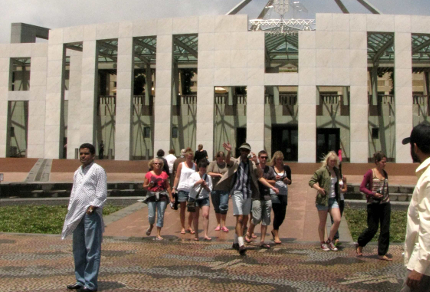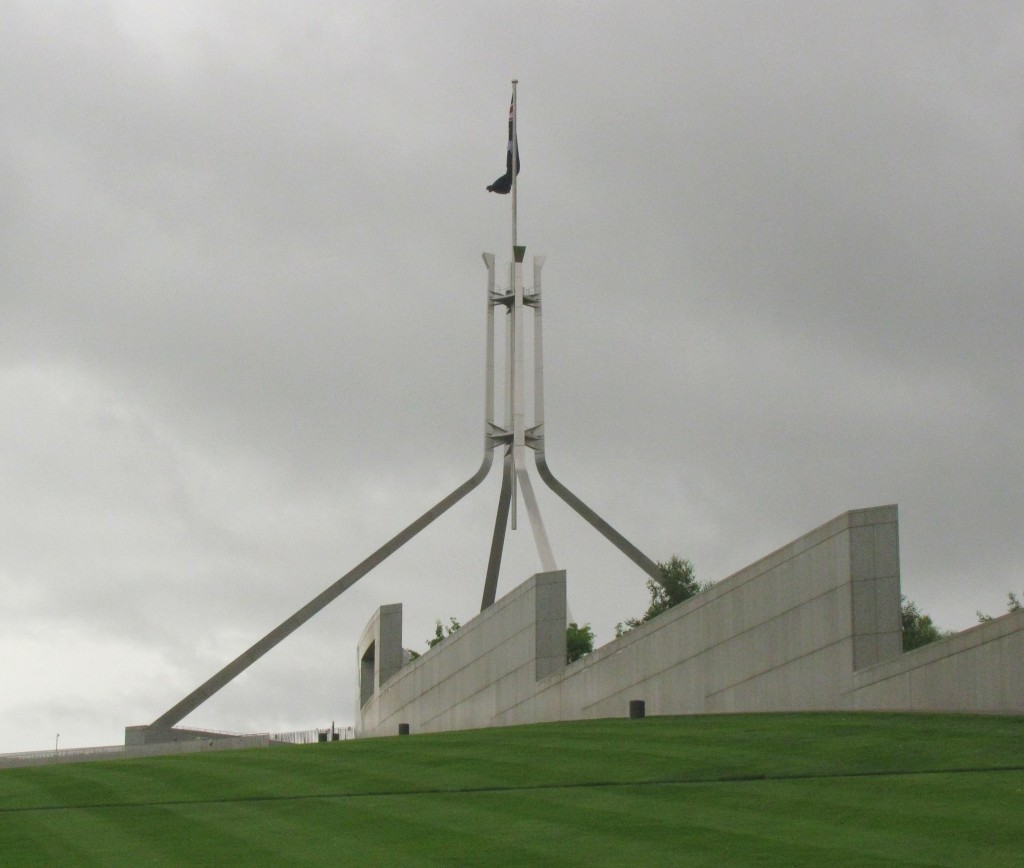
Parliament House, Canberra (© Magi Nams)
Late last evening and into the night, thunderstorms racked the skies over Canberra and poured torrential rains upon city streets. This morning, those streets remained wet, the sky above them dull and overcast with clouds threatening more rain in sagging bellies. With umbrella in hand, I headed south on Northbourne Street, skirted City Hill, and crossed Lake Burley Griffin via the Commonwealth Avenue bridge. My destination for the day was three-fold – Parliament House, the National Gallery of Australia, and the National Library of Australia.
From the bridge, I saw the Telstra Tower on Black Mountain shrouded in cloud. Drizzle speckled my umbrella and screened the National Museum of Australia on its spit of land protruding into the lake. On the far side of the lake, I spotted white-winged choughs bouncing from cut branch stump to stump in a tree as though they were springboard artists while heavy morning traffic whipped past them. I walked past High Commissions for Britain, New Zealand, and Canada, the last (my home country) with a Haida totem pole in its yard and maple leaves embossed into cement fence pillars and walls. After strolling through gardens adjacent to Capital Circle, I crossed the Aboriginal mosaic fronting Parliament House and entered the seat of this nation’s power just in time to join a tour of the building.
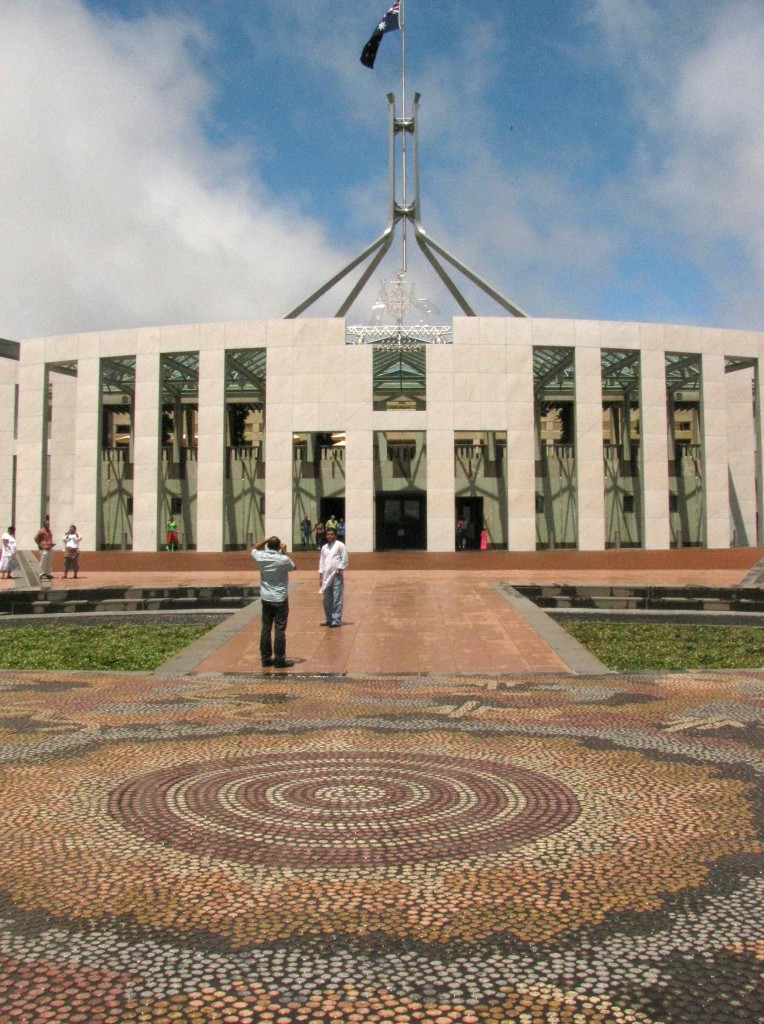
Aboriginal ‘Australia’ Mosaic at Parliament House, Canberra (© Magi Nams)
As most Australians would know, their country became an independent federation on January 1, 1901. In 1908, the Australian Capital Territory was formed by sequestering land from New South Wales. The new nation’s capital was to be located in neither Sydney nor in Melbourne, but between the two great rival cities. In 1911, Walter Burley Griffin won the competition to design the capital city, and in 1927 the Australian Parliament moved to Canberra from its temporary home in Melbourne. Old Parliament House, where Vilis and I dined last evening at the Ecological Society of Australia’s conference banquet, was the Australian Parliament’s first Canberra home. The current Parliament House was designed by Romaldo Giurgola, his design chosen from among 329 entries, and the finished product of his genius officially opened by Queen Elizabeth on May 9, 1988.
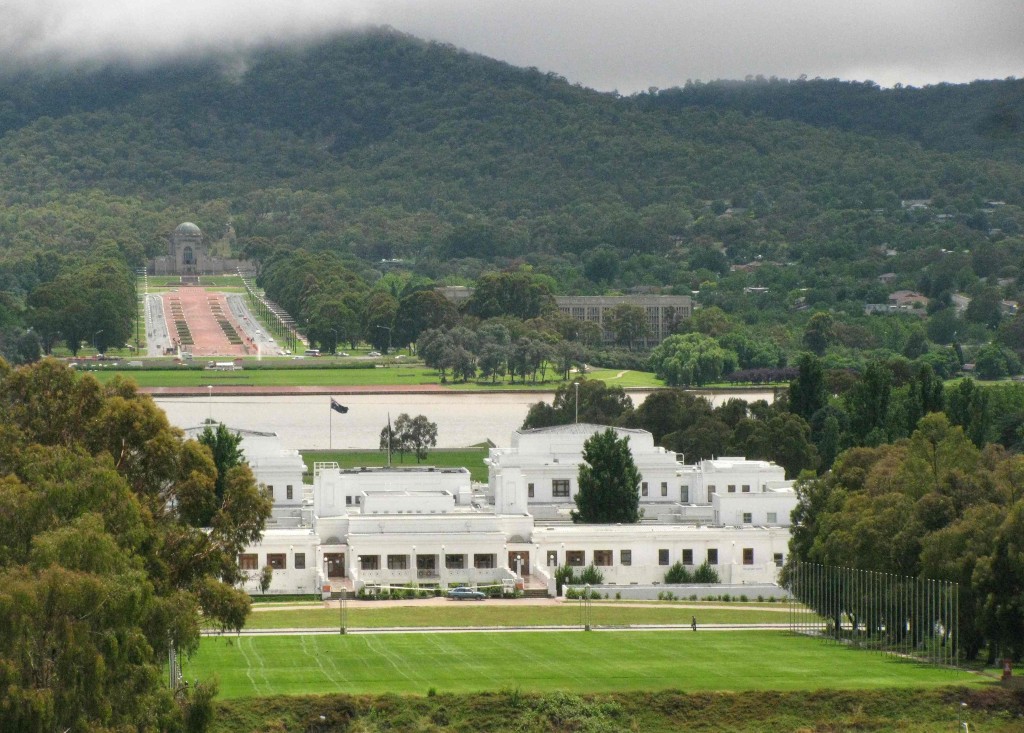
Old Parliament House, Canberra, with Anzac Parade and the Australian War Memorial in the Background (© Magi Nams)
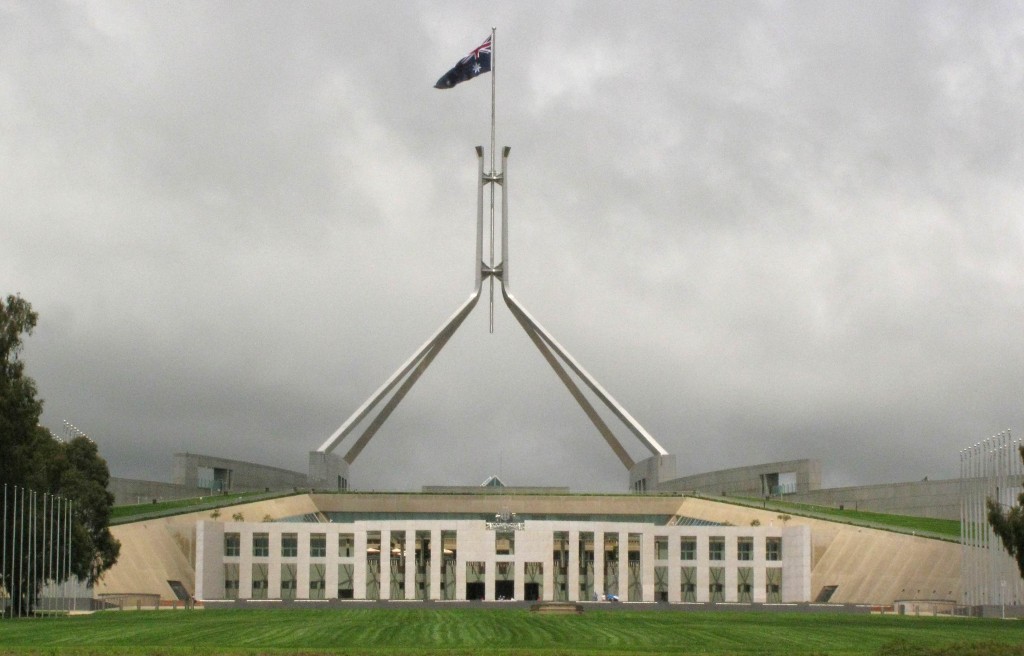
Parliament House, Canberra (© Magi Nams)
During my tour, I learned a swag of interesting tidbits about Parliament House and the Australian government, a few of which I’ll relate here. First, Parliament House was built into Capital Hill – not on top of it – to signify that the Australian Parliament is not above its people, but rather, that the people are above Parliament, or in different words, that the government serves the people and not the other way around. The buttressed flagpole rises 81 metres above Parliament House, with the Australian flag atop it being the size of a tennis court. The Australian flag incorporates three design elements – the Union Jack signifying Australia’s historical ties with Great Britain, the Southern Cross constellation composed of five white stars reflecting the country’s position within the Southern Hemisphere, and the Federation or Commonwealth Star beneath the Union Jack possessing seven points, six of which represent Australia’s six states, and the last representing the two territories.
Parliament House features stunning and symbolic construction and decoration elements – the Aboriginal mosaic forecourt symbolizing the land and the place of Aborigines in Australian culture; the Great Hall Tapestry depicting an Australian woodland that incorporates all those muted, dusky, dusty greens, greys, whites and pinks I’ve seen and sets them against a brilliant blue sky glimpsed through never-ending, horizonless forest (open savannah woodland, I figure). Rich timbers (particularly the red jarrah wood of the Great Hall floor) and marble pillars are symbolic of European influence on this country. The shades of green in the House of Representatives chamber reflect the colours of gum tree leaves, while the shades of red and pink in the Senate chamber reflect the colours of eucalypt flowers. Each of the U-shaped chambers was designed as a debating chamber, with government and opposition members facing each other across the central floor of the chamber.
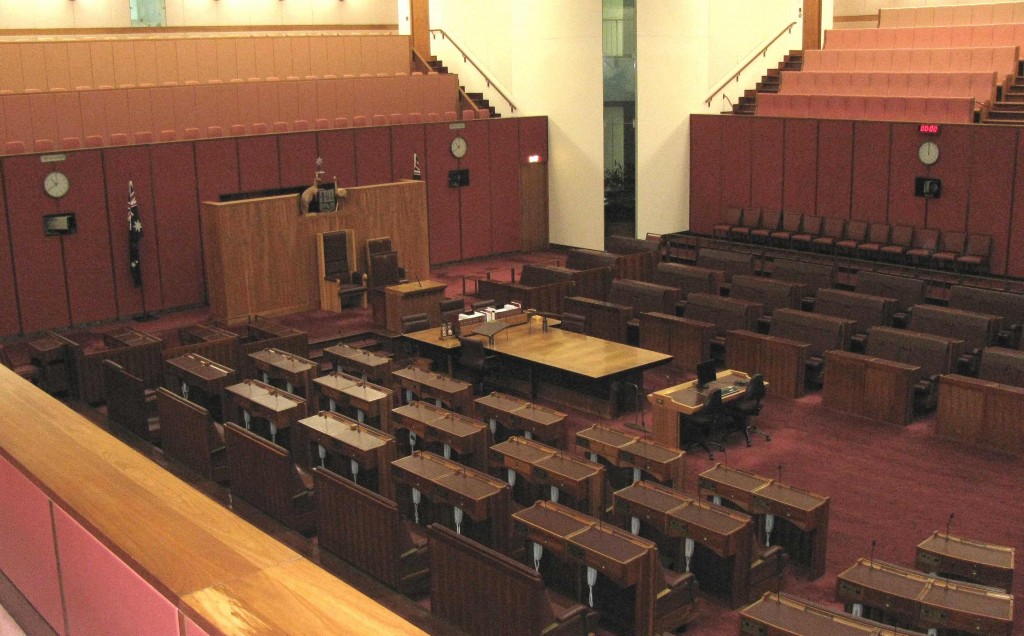
Senate Chamber, Parliament House, Canberra (© Magi Nams)
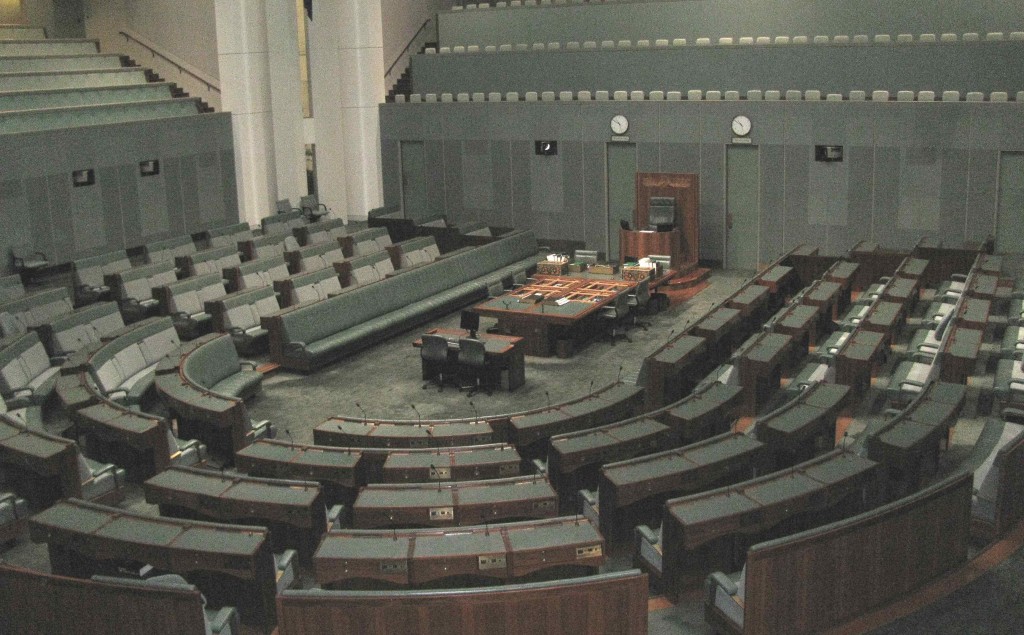
House of Representatives Chamber, Parliament House, Canberra (© Magi Nams)
Rain thundered down outdoors while I, after the tour finished, browsed about on my own. I walked across the Great Hall and peered closely at that woodland tapestry. I gazed upon an aged, stained copy of the Magna Carta – one of only four known remaining copies – and sipped hot chocolate and ate cherry cake in the cafeteria to kill time until the downpour ceased. When ephemeral patches of blue sky appeared among the clouds, I rode the lift to the Parliament House roof and gazed out upon Walter Burley Griffin’s planned capital city, with its spokes of major avenues linking Capital Hill and Canberra’s Cental Business District across the lake with satellite residential districts.
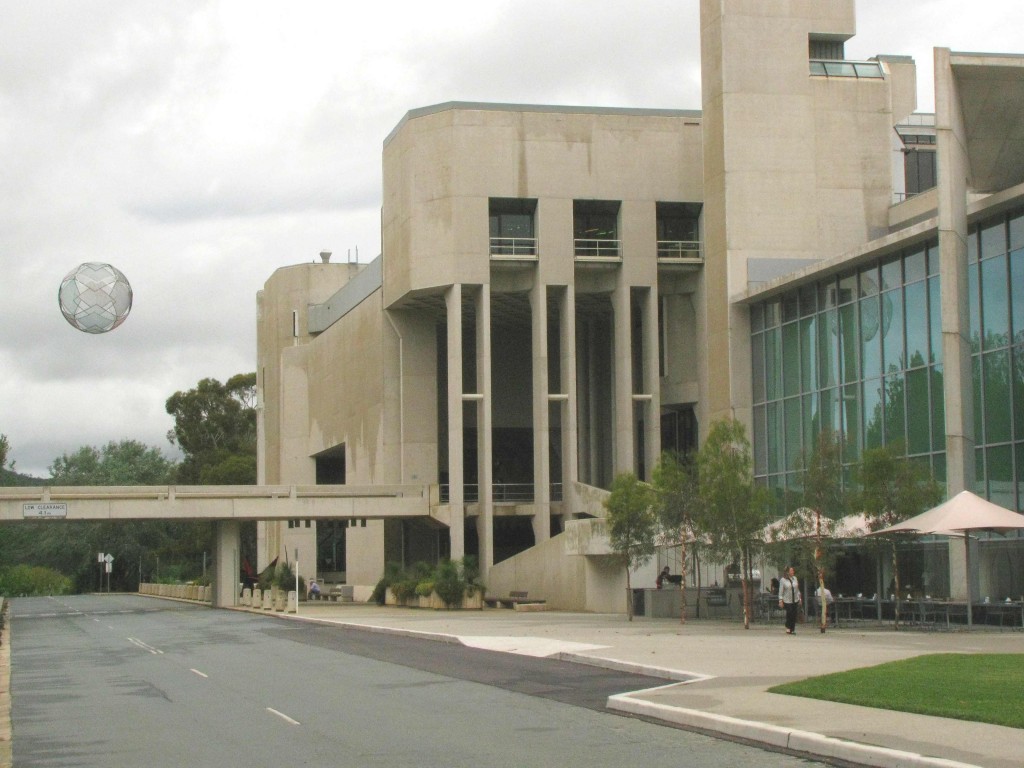
National Gallery of Australia (© Magi Nams)
After rather surprisingly and enjoyably having spent the entire morning and early afternoon at Parliament House, I strolled northeast from Capital Hill to the National Gallery of Australia located on the shore of Lake Burley Griffin. Painted poles crafted by Raminingining artists of Central Arnhem Land created a spare forest of red and yellow ochre, white and black designs on the main floor near the entrance, and I discovered other Indigenous artistic treasures – echidna quill and iridescent snail shell necklaces, woven grass, pandanus, and lawyer cane baskets dyed with stunning natural dyes in shades of orange and green, brown, burgundy, black, and white. A kelp water carrier made from rich burgundy kelp was puckered and skewered with wood around its brim, to which a twisted grass handle was attached. I spotted the waterholes, pathways, and sand in Western Australian desert art, and stylized depictions of rivers, stars, fishes, lizards, dingoes, kangaroos, and crayfish. After Vilis’s and my trip to Alice Springs, Albert Namatjira’s watercolour paintings looked familiar – the red rock and white ghost gums.

Cones, National Gallery of Australia’s Sculpture Garden (© Magi Nams)
Outdoors, the gallery’s Sculpture Garden held a few abstract metal constructions and sculpted figures, but also much more intriguingly, a chain of polished steel Cones created by Burt Flugelman and seemingly frozen in time, a tray of gigantic, lush pears cast from cor-ten steel by George Baldessin and titled Pear – version number 2, and Fog Sculpture by Fujiko Nakaya, which was the most inventive sculpture I’d ever seen. Nakaya’s creation consisted of grids of pipe nozzles placed around the edges of a miniscule wetland, the nozzles positioned to shoot clouds of mist out over the wetland. Superb fairy-wrens flitted through the eerie mist, becoming part of the billowing sculpture.
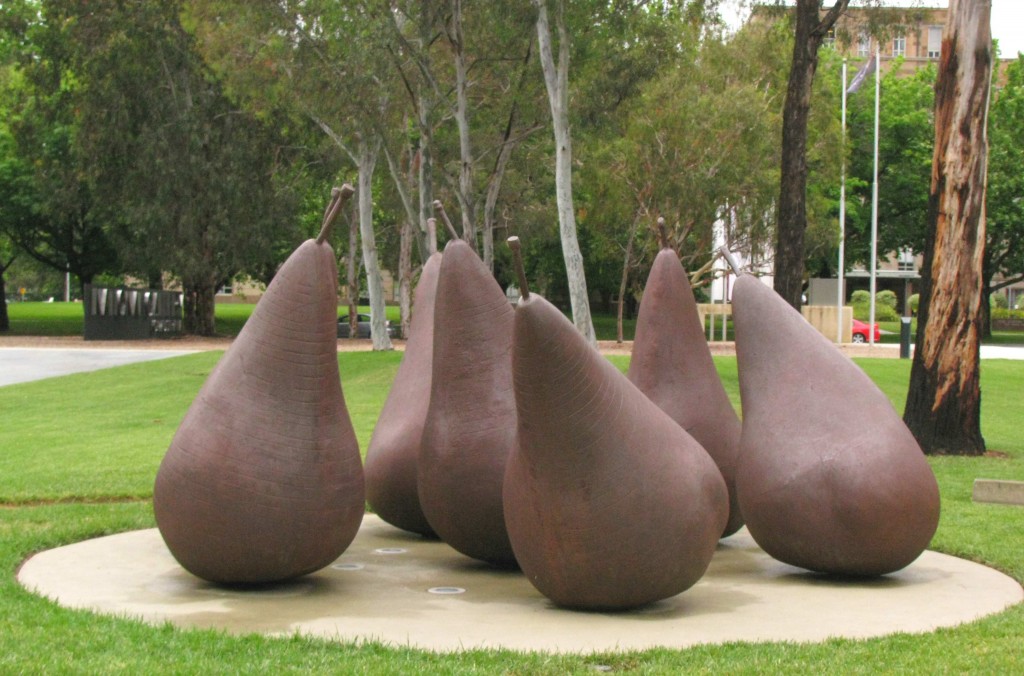
Pear – version number 2, National Gallery of Australia (© Magi Nams)
With dark clouds churning overhead, I hurried from the gallery northwest along the lakeshore toward the National Library of Australia, where I hoped to view a logbook written by Captain James Cook, as well as journals from the disastrous Burke and Wills Expedition. The lake lay swollen beside me, enlarged by the heavy rains of last night and this morning, a strong current sweeping flood-torn trees and other vegetative debris through its centre. Bells from the National Carillon on the north shore rang out over the flooded lake and lakeshore parks, and a man ran past me, urging me to seek shelter because of imminent rain.
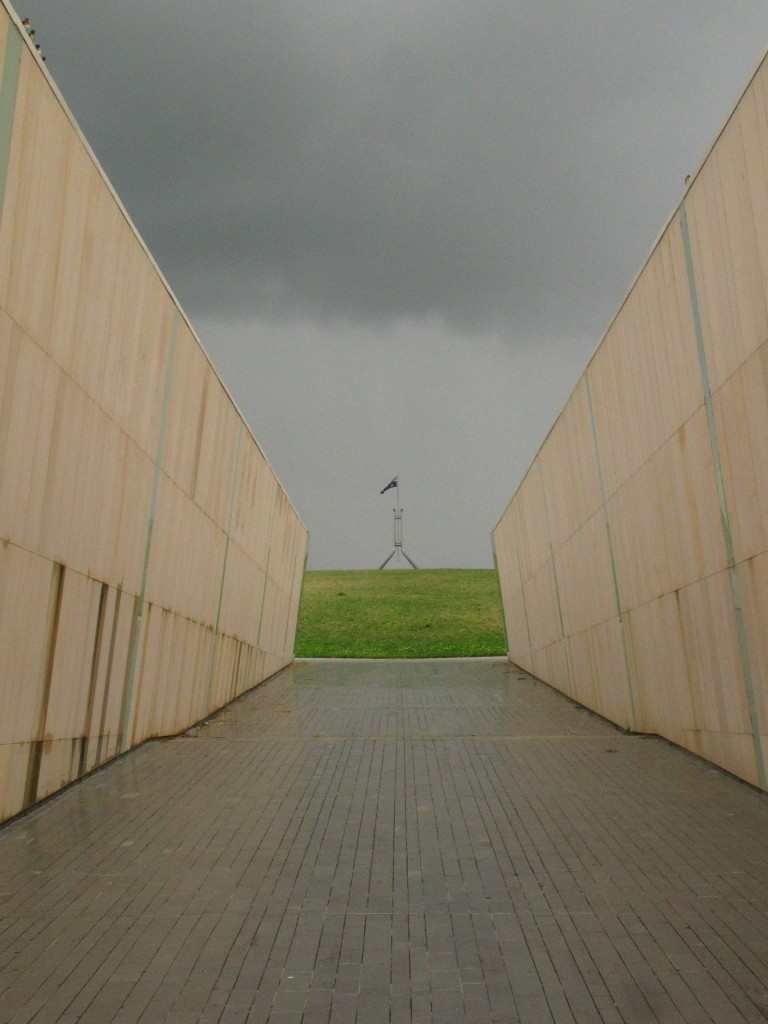
Stormy Sky over the Australian Capital (© Magi Nams)
That rain arrived before I arrived at the library, a violent downpour pounding streets and sculptures and soaking my umbrella and sneakers. I dashed up the library’s stairs and stood a moment looking out at a metal sculpture depicting a stylized bowerbird avenue bower and ornament gracing Reconciliation Place near the library, now screened by a hail of raindrops. On entering the library, I discovered that both the documents I wished to view were in storage, so I called it a day and headed for Novotel. The rain – as capricious as it was violent – had ceased, allowing me to photograph the bower sculpture, called Fire and Water and created by Judy Watson, before I quickly crossed the bridge over Lake Burley Griffin, leaving Parliament House and the country’s national gallery and library behind me.
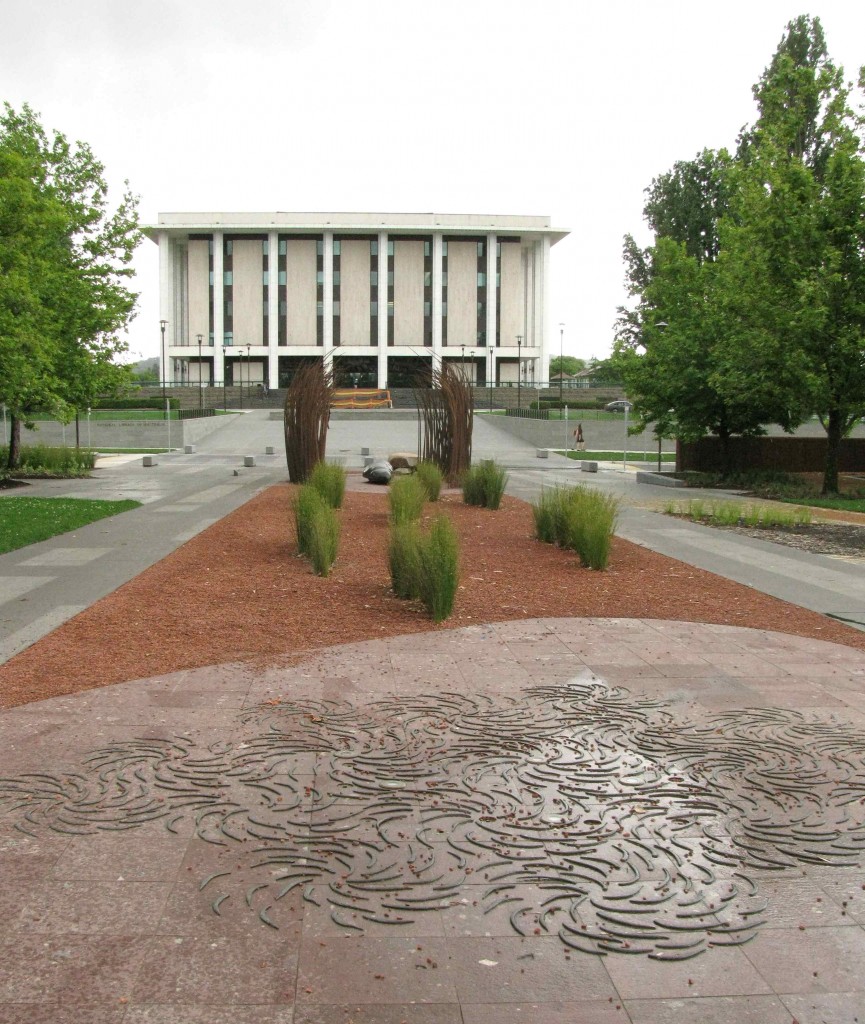
National Library of Australia and Reconciliation Place (© Magi Nams)
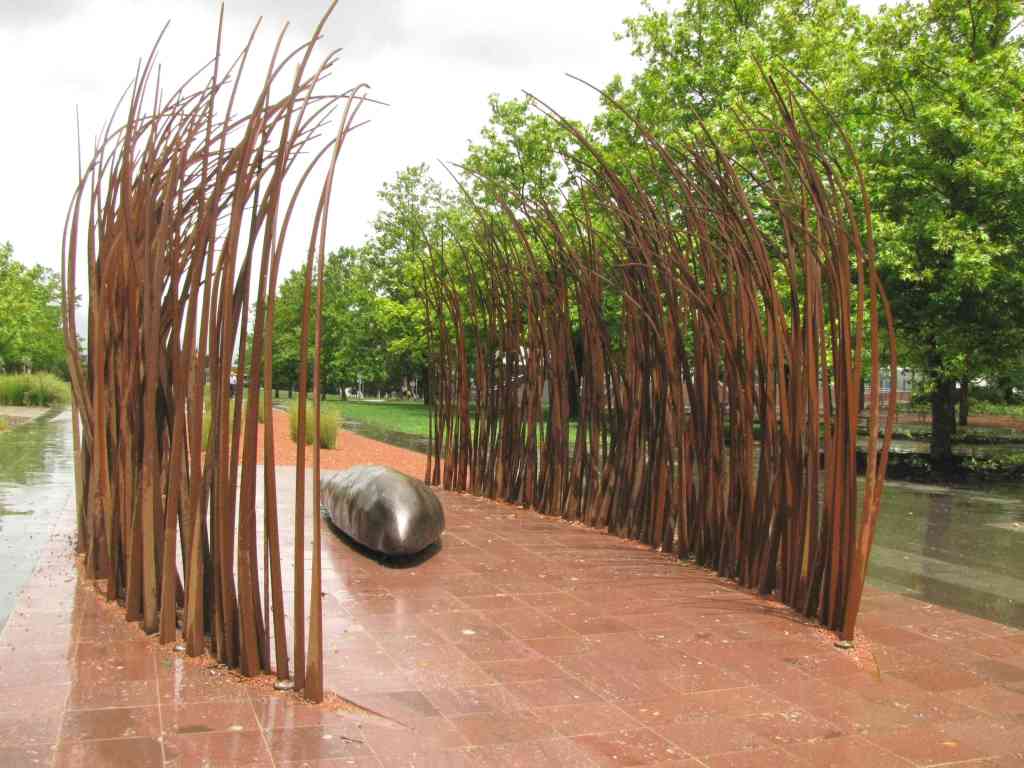
Detail of Fire and Water, Reconciliation Place, Canberra (© Magi Nams)
Today’s birds: rock doves, Australian magpies, magpie-larks, noisy miners, white-winged choughs, Australian raven, red wattlebird, superb fairy-wren, Australian wood ducks, welcome swallows, starlings, mynas, crimson rosella, crested pigeons, galahs, white-browed scrubwrens, white-plumed honeyeater, black swans, silver gulls, black-faced cuckoo-shrike, red-rumped parrot, pied cormorant, little black cormorant, Australian white ibises, willie wagtail, sulphur-crested cockatoo, blackbird.

